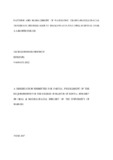| dc.contributor.author | Ndung’u, George M | |
| dc.date.accessioned | 2017-12-18T12:03:13Z | |
| dc.date.available | 2017-12-18T12:03:13Z | |
| dc.date.issued | 2017 | |
| dc.identifier.uri | http://hdl.handle.net/11295/102005 | |
| dc.description.abstract | Introduction
Trauma is among the leading causes of death in all age groups except those above 60 years,
according to the WHO. Noteworthy, trauma patterns and aetiology differ among various
age groups and geographical regions. It is estimated that approximately 11.3 % of all
paediatric emergency room visits are due to facial trauma. Studies on paediatric craniomaxillofacial
(CMF) trauma in Kenya are few and are presented as part of general CMF
trauma.
Objective
The main objective of this study was to prospectively determine the pattern and
management of paediatric CMF trauma at the main teaching and referral hospital in Kenya
over a 6-month period.
Materials & Methods
This was a cross-sectional descriptive study carried out at Kenyatta National Hospital
between April and September 2016. A data collection form was used to document the
age, gender, aetiology and pattern of CMF trauma and associated injuries. In addition,
management protocols prescribed for these injuries were documented.
Results
Seven hundred and five (705) physically injured children and adolescents presented to
KNH during the 6-month study period and among these, 210 (29.8 %) had
craniomaxillofacial injuries with a mean age of 7.4 years (SD= 5.6 years). Accidental falls
(44 %) were the main cause of CMF injuries followed by motor vehicle crashes (22 %).
Interpersonal violence (IPV) had a statistically significant association with the age of the
child, mostly affecting older children with a mean age of 13.2 years (SD= 5.3 years);
xi
ANOVA (F=14.34, df=4, p< 0.0001). IPV was also more likely to be a cause of CMF in
boys than girls (c2 = 10.485, df=4, p=0.0330).
Among sixty-six children (31.4%, n=210) who presented with a total of 116 facial
fractures, mandibular fractures were the most common with 50 (42.7 %) fractures affecting
the mandible. The mandibular condyle was the most likely anatomic region of the
mandible to sustain fractures with 32 % of mandibular fractures occurring in this site
(n=50). Management of facial fractures was predominantly conservative or through closed
reduction (79 %) with 14 patients (21 %, n=66) managed through ORIF. ORIF was more
likely to be used in older children (mean age =11.0 years, SD= 5.5) and those with
mandibular fractures (50%, n=14) or panfacial fractures (35.7 %, n=14).
Conclusion
Accidental falls were the main cause of paediatric CMF trauma followed by road traffic
crashes. Cranio-maxillofacial injuries constituted approximately a third (29.8 %) of all
paediatric injuries recorded in this study with the mandible being the most fractured facial
bone, with its condylar process being the most fractured region. ORIF for paediatric facial
fractures was more likely to be prescribed for older children and in particular those with
mandibular fractures or panfacial fractures.
Recommendation
Since we have found that accidental falls and road traffic crashes are probably the leading causes
of paediatric cranio-maxillofacial trauma in Kenya, preventive measures to reduce the paediatric
trauma burden should focus on reducing the occurrence of falls and road traffic accidents | en_US |
| dc.language.iso | en | en_US |
| dc.publisher | University of Nairobi | en_US |
| dc.rights | Attribution-NonCommercial-NoDerivs 3.0 United States | * |
| dc.rights.uri | http://creativecommons.org/licenses/by-nc-nd/3.0/us/ | * |
| dc.subject | Paediatric Cranio-Maxillofacial Traumatic Injuries | en_US |
| dc.title | Pattern and management of paediatric cranio-maxillofacial traumatic injuries seen at the Kenyatta National Hospital Over A 6-month period | en_US |
| dc.type | Thesis | en_US |
| dc.description.department | a
Department of Psychiatry, University of Nairobi, ; bDepartment of Mental Health, School of Medicine,
Moi University, Eldoret, Kenya | |



